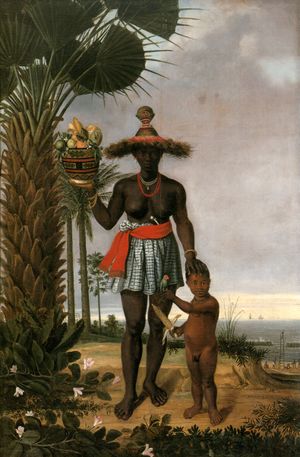البرازيل الهولندية
Dutch Brazil / New Holland Nederlands-Brazilië or Nieuw-Holland | |||||||||
|---|---|---|---|---|---|---|---|---|---|
| 1630–1654 | |||||||||
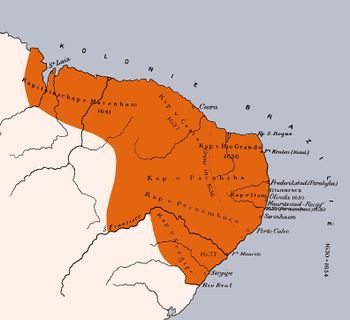 Dutch Brazil 1630-1654 | |||||||||
| الوضع | Dutch colony | ||||||||
| العاصمة | Mauritsstad (Recife) | ||||||||
| اللغات المشتركة | Dutch Indigenous languages | ||||||||
| الدين | Dutch Reformed | ||||||||
| الحكومة | Colony | ||||||||
| Governor | |||||||||
• 1637–1643 | John Maurice, Prince of Nassau-Siegen | ||||||||
• 1643–1654 | Dutch West India Company | ||||||||
| التاريخ | |||||||||
• Start | 16 February 1630 | ||||||||
• Arrival of Maurice of Nassau | 23 January 1637 | ||||||||
| 19 April 1648 | |||||||||
| 19 February 1649 | |||||||||
| 28 January 1654 | |||||||||
| العملة | Braziliaanse Guldens (Brazilian Guilders) | ||||||||
| |||||||||
| اليوم جزء من | |||||||||
البرازيل الهولندية، تعرف أيضاً باسم هولندا الجديدة، كانت الجزء الشمالي من البرازيل، يحكمها جمهورية هولندا خلال الاستعمار الهولندي في الأمريكتين بين 1581 و1654. مصطلح "هولندا الجديدة" لا ينبغي الخلط بينه وبين هولندا الجديدة (أستراليا)، أستراليا الغربية.
محتويات
1 انظر أيضاً
2 ملاحظات
3 مراجع
4 مصادر خارجية
انظر أيضاً
جزء من سلسلة حول
تاريخ البرازيل
شعار البرازيل
قبل الاستعمار˂
مستعمرة البرازيل˂
المملكة المتحدة لبرتغال والبرازيل والغرب˂
إعلان استقلال البرازيل˂
إمبراطورية البرازيل˂
الجمهورية القديمة˂
حقبة فارجاس˂
الجمهورية الثانية˂
الحكم العسكري˂
الجمهورية الجديدة˂
سنوات في البرازيل˂
شعار بوابة
بوابة البرازيل عنت شركة الهند الغربية الهولندية برنامبوكو
. . . . . . . . . . . . . . . . . . . . . . . . . . . . . . . . . . . . . . . . . . . . . . . . . . . . . . . . . . . . . . . . . . . . . . . . . . . . . . . . . . . . . . . . . . . . . . . . . . . . . . . . . . . . . . . . . . . . . . . . . . . . . . . . . . . . . . . . . . . . . . . . . . . . . . . . . . . . . . . . . . . . . . . .
Early Iberian-Dutch relations
Northeastern Brazil in the Golden Age of Dutch Rule
Establishment of Dutch Brazil
Dutch Brazil under Johan Maurits van Nassau-Siegen
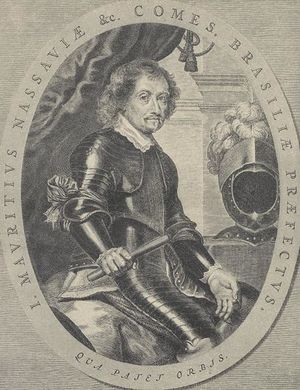
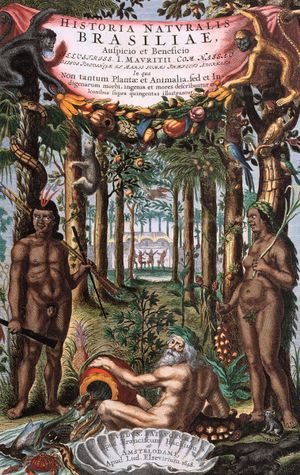
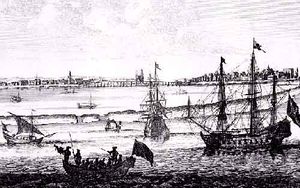
In 1637, the WIC gave control of its Brazilian conquests, now called "Nieuw Holland," to Johan Maurits van Nassau-Siegen (John Maurice of Nassau), the great-nephew of William the Silent. Within the year, Johan Maurits captured the Brazilian province of Ceara and sent an expedition to capture the West African trading post of Elmina Castle, which became the capital of the Dutch Gold Coast. In 1641 the Dutch captured the province of Maranhao, meaning that Dutch control now extended across the entire coastline between the Amazon and Sao Francisco Rivers.[2]
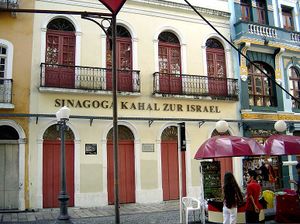
Governance under Maurits
| Main Dutch Brazilian Cities | |
|---|---|
| Dutch colonial Name | Today |
| Mauritsstad | Recife |
| Frederikstadt | João Pessoa |
| Nieuw-Amsterdam | Natal |
Population of Dutch Brazil
The end of Dutch Brazil
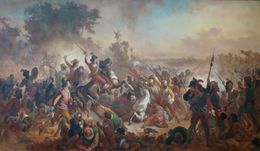
In Brazil, the Dutch had already abandoned Itamaracá on December 13, 1647. The new expeditionary force arrived late at Recife, with many of its soldiers either dead or mutinous from lack of pay. In April 1648, the Portuguese routed the expeditionary force at the First Battle of Guararapes, fought outside Recife. The Portuguese had sent an armada of 84 ships, including 18 warships to recapture Recife.[4] In February 1649, the Portuguese again routed the Dutch at the Second Battle of Guararapes.[5]
Recapture of Recife
| Reconquest of Recife | |||||||
|---|---|---|---|---|---|---|---|
| جزء من Dutch-Portuguese War | |||||||
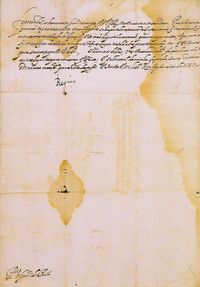 A letter written by the Portuguese King John IV ordering the attack on Recife | |||||||
| |||||||
| المتحاربون | |||||||
|
| |||||||
| القادة والزعماء | |||||||
|
Francisco Barreto Pedro Jacques de Magalhães[6] | Walter Van Loo [6] | ||||||
| القوى | |||||||
| 2,500 men [6] | Unknown | ||||||
| الضحايا والخسائر | |||||||
| Unknown | Unknown | ||||||
The Reconquest of Recife was a military engagement between the Portuguese forces under Francisco Barreto de Meneses and the Dutch forces of Captain Walter Van Loo.[7] After the Dutch defeats at Guararapes, their surviving men, as well as other garrisons of New Holland, joined in the area of Recife in order to make a last stand. However, after fierce fighting, the Portuguese victoriously entered the city and the remaining Dutch were ousted from Brazil.
The Dutch finally lost control of Recife on January 28, 1654, leaving to the Portuguese their colony of Brazil and putting an end to Nieuw Netherlands.[8]
. . . . . . . . . . . . . . . . . . . . . . . . . . . . . . . . . . . . . . . . . . . . . . . . . . . . . . . . . . . . . . . . . . . . . . . . . . . . . . . . . . . . . . . . . . . . . . . . . . . . . . . . . . . . . . . . . . . . . . . . . . . . . . . . . . . . . . . . . . . . . . . . . . . . . . . . . . . . . . . . . . . . . . . .
Role of the Amerindians and Africans

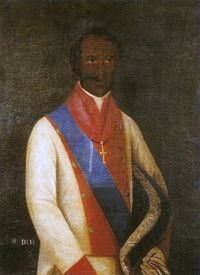
Peace treaty
Seven years after the surrender of Recife, a peace treaty was organized between the Dutch Republic and Portugal. The Treaty of The Hague (1661) was signed on August 6, 1661,[9] and it demanded that the Portuguese would pay 4 million réis over the span of 16 years in order to help the Dutch recover from the loss of Brazil.
See also
- Colonial Brazil
- Dutch West India Company
- Dutch Brazilian
- 17th century Dutch Brazil:
- Recife and Pernambuco:
- Others:
References
- ^ "Maurício de Nassau, o brasileiro Mariana Lacerda". Archived from the original on 2014-12-23. Retrieved 2014-12-12.
- ^ Parker 1976, p. 70-71.
- ^ Bloom, Hebert Ivan. The Economic activities of the Jews in Amsterdam in the seventeenth and eighteenth centuries.
- ^ Dutra, "Dutch in Colonial Brazil", p. 418.
- ^ Parker 1976, p. 72.
- ^ أ ب ت Paula Lourenço p.78
- ^ Lourenço, Paula.Battles of Portuguese History - Defence of the Overseas. - Volume X. (2006), p. 78
- ^ Facsimile of manuscript regarding the surrender of Dutch Brazil:Cort, Bondigh ende Waerachtigh Verhael Wan't schandelyck over-geven ende verlaten vande voorname Conquesten van Brasil...;
- ^ Facsimile of the treaty:Articulen van vrede en Confoederarie, Gheslooten Tusschen den Doorluchtighsten Comingh van Portugael ter eenre, ende de Hoogh Mogende Heeren Staten General ...;
Further reading
- Barlaeus, The History of Brazil Under the Governorship of Count Johan Maurits of Nassau, 1636-1644. Gainesville: University of Florida Press 2011.
- Boxer, C.R., The Dutch in Brazil, 1624–1654, The Clarendon press, Oxford, 1957. ISBN 0-208-01338-5
- Boogaart, Ernst Van den, et al. Johan Maurits van Nassau-Siegen, 1604-1679: A Humanitst Prince in Europe and Brazil. The Hague: Johan Maurits van Nassau Stichting 1979.
- Dutra, Francis A. "Dutch in Colonial Brazil" in Encyclopedia of Latin American History and Culture, New York: Charles Scribner's Sons 1996, vol. 2, pp. 414–420.
- Feitler, Bruno. "Jews and New Christians in Dutch Brazil, 1630-1654," in Richard L. Kagan and Philip D. Morgan, eds. Atlantic Diasporas. Jews, conversos, and Crypto-Jews in the Age of Mercantilism, 1500-1800. Baltimore: Johns Hopkins University Press 2009, 123-51.
- Groesen, Michiel van. "Lessons Learned: The Second Dutch Conquest of Brazil and the Memory of the First," Colonial Latin American Review 20-2 (2011) 167-93.
- Groesen, Michiel van, Amsterdam's Atlantic: Print Culture and the Making of Dutch Brazil, University of Pennsylvania Press, Philadelphia, 2017. ISBN 978-0-8122-4866-1
- Groesen, Michiel van (ed.), The Legacy of Dutch Brazil, Cambridge University Press, New York, 2014. ISBN 978-1-107-06117-0
- Israel, Jonathan I. "Dutch Sephardi Jewry, Millenarian Politics, and the Struggle for Brazil (1645-54)." In Diasporaporas Winthin a Disapora. Jonathan I. Israel, ed. Leiden: Brill 2002.
- Israel, Jonathan, Stuart B. Schwartz, and Michiel van Groesen. The expansion of tolerance: religion in Dutch Brazil (1624-1654). Amsterdam University Press, 2007.
- Joppien, Rüdger. "The Dutch Vision of Brazil: Johan Maurits and His Artists," in Johan Maurits van Nassau-Siegen, 1604-1679: A Humanist Prince in Europe and Brazil, ed. Ernst van den Boogaart, et al. 297-376. The Hague: Johan Maurits van Nassau Stichting, 1979.
- Klooster, Wim. “The Geopolitical Impact of Dutch Brazil on the Western Hemisphere.” In The Legacy of Dutch Brazil, edited by Michiel van Groesen, 25-40. Cambridge: Cambridge University Press, 2015.
- Novinsky, Anita. “A Historical Bias: The New Christian Collaboration with the Dutch Invaders of Brazil (17th Century).” In Proceedings of the 5th World Congress of Jewish Studies, II.141-154. Jerusalem: World Union of Jewish Studies, 1972.
- Parker, Geoffrey (1976). "Why Did the Dutch Revolt Last Eighty Years?". Transactions of the Royal Historical Society. 26.
{{cite journal}}: Invalid|ref=harv(help) - Schmidt, Benjamin, Innocence Abroad: The Dutch Imagination and the New World, 1570-1670, Cambridge: University Press, 2001. ISBN 978-0-521-80408-0
- Wiznitzer, Arnold. Jews in Colonial Brazil. New York: Columbia University Press, 1960.
External links
- Dutch West Indies 1630–1975 at YouTube
- Facsimiles of 20 manuscripts from the Dutch West India Company Relating about the events in Brazil in the 17th century (PT & NL)
- Guararapes Birth of the Brazilian Nationality Brazilian Armed Forces site
- The Dutch in Brazil
- History of Dutch Brazil and Guiana
- The New Holland Foundation
- World Statesmen – Brazil
- History of Portuguese America, in Portuguese, by Sebastião da Rocha Pita
- Short description is different from Wikidata
- Articles with hatnote templates targeting a nonexistent page
- Portal-inline template with redlinked portals
- Pages with empty portal template
- Brazil articles missing geocoordinate data
- All articles needing coordinates
- Dutch Brazil
- Colonial Brazil
- Former colonies in South America
- Former Dutch colonies
- 1630s in Brazil
- 1640s in Brazil
- 1650s in Brazil
- دول وأقاليم تأسست في 1630
- States and territories disestablished in 1654
- 1630 establishments in Brazil
- 1654 disestablishments in Brazil
- 1630 establishments in the Dutch Empire
- 1654 disestablishments in the Dutch Empire
- 1630 establishments in South America
- 1654 disestablishments in South America
- Former settlements and colonies of the Dutch West India Company
- 17th century in the Dutch Empire



